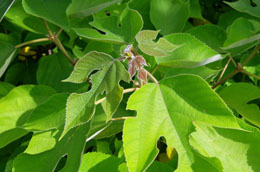Pruning fruitless mulberry is done for shaping the tree, controlling its size and removing weak branches. Adopt correct tips for fruitless mulberry tree pruning, and you can enjoy the sight of a healthy, disease free and well-shaped ornamental tree in your yard for many years to come.

The fruitless or male white mulberry is a popular landscaping tree in areas, where summer is long and the climate is hot. Basically introduced for the purpose of feeding silkworms, it has become a tree of choice for beautifying the yard. It belongs to the genus
Morus, which comprises about 16 species including the fruit bearing mulberry cultivar. Desired features of this 30-50 feet tall ornamental tree are lobed, bright green leaves, drooping branches and beautiful round shaped crown.
Tips on Pruning a Fruitless Mulberry Tree
Fruitless mulberry grows at a very fast rate and provides shade with its dense crown. Hence, it makes an excellent cultivar for growing in streets, public places and home garden. As compared to the fruit bearing mulberry, the fruitless variety is less messy. You don't need to clean up the fallen fruits every time during the peak season. Also, it is adapted to drought condition and grows luxuriantly in several types of soil. You can also maintain it within the desired height range to suit your landscape design.
This weeping mulberry tree calls for basic growth requirements, such as growing in moist soil, maintaining slight soil acidity (pH 6-6.5), exposure to partial or full sunlight and occasional trimming. Pruning is usually done once in every year or two years. For growing in a home garden, ensure that you trim it once in a year. Otherwise, the branches will overgrow and pruning after two years will become a challenging job. Detailed instructions for how to trim a fruitless mulberry tree are discussed below.
Pruning Time
Correct timing is crucial for cutting the branches of any tree. This especially holds true for mulberry, since it has the tendency to ooze more sap than other cultivars. So, when to prune a fruitless mulberry tree? The best time for pruning this deciduous tree is spring for a young tree, and late fall or early winter for an older tree. During this period, it remains dormant and less active. As a consequence, there is less risks for bleeding.
Pruning a Young Mulberry
For a young tree, most gardeners prefer cutting off the top portion along with its main branches. This technique known as pollarding allows seasonal growth of branches to about 10 feet and more during the growth season (spring). Besides this, shaping a young tree can be achieved with the help of crown reduction method. In this pruning technique, you are expected to keep the leader and lateral branches at uniform length.
Pruning an Older Mulberry
Pruning an old fruitless mulberry tree is proceeded to keep it strong and disease free. If you have been following pollarding technique, then you need to continue the same. The two thumb rules for pruning a older mulberry tree are retaining 2/3 of the original foliage which otherwise will weaken the tree, and making sure that the trimmed branches are distributed uniformly along the tree height.
If you remove excess branches from the bottom portion leaving more in the top crown, it will appear unsightly, which you don't want at any cost. As far as pruning a fruitless mulberry tree is concerned, mark the weak branches first and prune them close to the trunk, but above their knuckles (or collars). Any outward growing branch can be cut down in the same way. After removing the twigs, use pruning tars over the cut surfaces to minimize disease and pest infestations.
In a nutshell, removing the tree branches is a part of fruitless mulberry tree maintenance guidelines. This not only helps in shaping the crown, but also adds vigor to the tree. However, both fruitless and fruiting mulberry tree varieties are very sensitive to pruning and injuries. Hence, reducing cuts as much as possible is the objective to restore normal growth and vigor of this ornamental tree.






 The fruitless or male white mulberry is a popular landscaping tree in areas, where summer is long and the climate is hot. Basically introduced for the purpose of feeding silkworms, it has become a tree of choice for beautifying the yard. It belongs to the genus Morus, which comprises about 16 species including the fruit bearing mulberry cultivar. Desired features of this 30-50 feet tall ornamental tree are lobed, bright green leaves, drooping branches and beautiful round shaped crown.
The fruitless or male white mulberry is a popular landscaping tree in areas, where summer is long and the climate is hot. Basically introduced for the purpose of feeding silkworms, it has become a tree of choice for beautifying the yard. It belongs to the genus Morus, which comprises about 16 species including the fruit bearing mulberry cultivar. Desired features of this 30-50 feet tall ornamental tree are lobed, bright green leaves, drooping branches and beautiful round shaped crown.